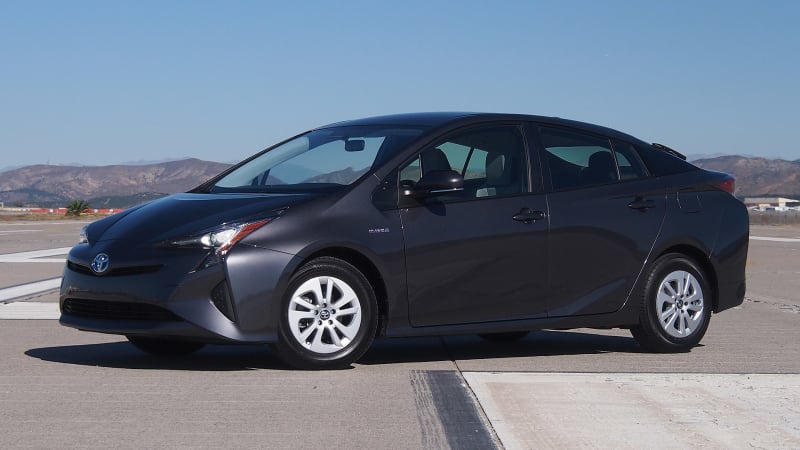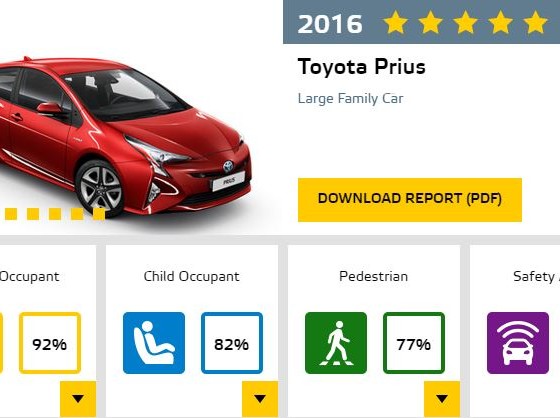Vehicles awarded IIHS Top Safety Pick awards skyrockets for 2015
![Vehicles awarded IIHS Top Safety Pick awards skyrockets for 2015 [w/video] Vehicles awarded IIHS Top Safety Pick awards skyrockets for 2015 [w/video]](http://o.aolcdn.com/dims-shared/dims3/GLOB/crop/1112x626+110+82/resize/800x450!/format/jpg/quality/85/http://o.aolcdn.com/hss/storage/midas/6cfeb965e0c3211406887ffa3139ce1b/201292969/IIHS-2015-Awards.jpg)
By practically every measure, passenger vehicles in the US are continuing to get safer. With the year rapidly coming to an end, the Insurance Institute for Highway Safety is releasing its annual list tallying of the scores for the latest vehicles to see how they compare to last year. Judging by the agency's evaluations, the numbers look quite positive.
According to the institute, 71 vehicles earned either the Top Safety Pick or Top Safety Pick+ rating so far in its testing for 2015. Among the latest winners, there have been 33 TSP+ awards and 38 TSP medalists. That's a healthy increase over the 22 TSP+ and 17 TSP grades in 2014.
The figures appear even more impressive when you consider that it keeps getting harder to earn the + designation. In the latest round of testing, a vehicle must offer some form of front crash prevention automatic braking to get the mark. Previously, just a warning to drivers was necessary.
This list also illustrates the ways that automakers adapt to new testing procedures. In 2013 there were 117 TSP ratings and 13 TSP+ awards. Then, the IIHS mandated that to be a safety pick, a model had to score Good in the institute's four crash tests, plus a Good or Acceptable in the small overlap front test. That brought a plunge in 2014 to just 17 TSP grades. With the numbers climbing again, companies apparently have deciphered how to perform better.
Some brands especially stood out on this year's list. The IIHS praised Volvo, Mercedes-Benz and Acura for offering standard front crash prevention systems on some models. Subaru received at least one of the awards for all seven of its models. Toyota also had seven, and the Honda brand did too - though the institute counts the two- and four-door versions of the Civic and Accord separately.
Check out the full announcement below and a video about this year's winners. The full list can be viewed, here.
Show full PR text Safety gains ground: More vehicles earn top honors from IIHS
The number of vehicles earning either of the Institute's two awards has jumped to 71 from 39 this time last year, giving consumers more choices for optimum protection in crashes. The number of winners in the top tier - TOP SAFETY PICK+ - has increased by 11 for 2015, despite a tougher standard for front crash prevention.
"This is the third year in a row that we are giving automakers a tougher challenge to meet," says IIHS President Adrian Lund. "The quest for TOP SAFETY PICK and TOP SAFETY PICK+ awards is driving improvement in the small overlap front crash test and getting manufacturers to offer automatic braking technology on more and more vehicles."
While the bar has been raised for TOP SAFETY PICK+, the criteria for TOP SAFETY PICK are unchanged: a good or acceptable rating in the small overlap front test and a good rating in each of the Institute's four other crashworthiness evaluations - moderate overlap front, side, roof strength and head restraints (see "A higher standard: 39 vehicles meet new criteria for TOP SAFETY PICK, TOP SAFETY PICK+," Dec. 19, 2013). The 2015 TOP SAFETY PICK+ designation is awarded to vehicles that meet those criteria and also have an available front crash prevention system that earns an advanced or superior rating.
For 2014, vehicles could qualify for TOP SAFETY PICK+ with only a basic rating for front crash prevention. Warning systems that meet the National Highway Traffic Safety Administration's performance criteria but don't include autobrake qualify for a basic rating. For an advanced or superior rating, vehicles must stop or slow down without driver intervention before hitting a target in IIHS tests at 12 mph, 25 mph or both (see "First crash avoidance ratings under new test program: 7 midsize vehicles earn top marks," Sept. 27, 2013).
As a result of the change in criteria for 2015, 15 vehicles that qualified for 2014 TOP SAFETY PICK+ are now simply TOP SAFETY PICK winners. In all, there are 33 TOP SAFETY PICK+ winners and 38 TOP SAFETY PICK winners.
"Although forward collision warning on its own is a valuable feature, we decided to tighten our criteria to encourage manufacturers to offer autobrake. Systems that don't require a driver response to avoid or mitigate a crash have the most potential for reducing crashes," Lund says. "Nevertheless, the models that are losing their plus signs are still great choices for safety, as are all the TOP SAFETY PICK winners."
Meeting the small overlap challenge
Most vehicles produced in recent years have had little trouble with the Institute's moderate overlap front, side, roof strength and head restraint tests. The small overlap front test, which replicates what happens when the front corner of a vehicle collides with another vehicle or an object such as a tree or a utility pole, represented a new hurdle when it was introduced in 2012 (see "Small overlap crashes: New consumer-test program aims for even safer vehicles," Aug. 14, 2012). The test is difficult because the crash forces bypass most of a vehicle's energy-absorbing structure. But small overlap crashes are common in the real world, so the Institute wanted to push manufacturers to look for solutions.
For 2013, IIHS continued to award TOP SAFETY PICK to vehicles that earned good ratings in the four older tests, regardless of their small overlap ratings. Those with good or acceptable small overlap ratings earned TOP SAFETY PICK+. Only 13 vehicles managed it at the beginning of the award year (see "Family cars trump luxury models in rigorous new crash test; top performance earns 13 cars 2013 TOP SAFETY PICK+," Dec. 20, 2012).
Since then, automakers have steadily increased the number of good or acceptable small overlap ratings by factoring in the test when they redesign a vehicle or introduce a new model and by making modifications to the structure and airbags between redesigns.
The Honda CR-V, a 2015 TOP SAFETY PICK+ winner, is an example of a vehicle that was successfully modified for improved protection. Previously, the small SUV earned a marginal rating when it was tested in 2012. The structure didn't hold up, with intrusion into the driver space exceeding 1 foot. The dummy's head barely contacted the front airbag before sliding off as the steering column moved to the right.
Honda made changes to the vehicle's front-end structure, occupant compartment and restraint system for the 2015 model year. In the most recent test, maximum intrusion was 5 inches at the parking brake pedal, and the dummy's head remained on the front airbag until rebound. Today's CR-V earns a good rating.
The Toyota Prius v, which also earns TOP SAFETY PICK+, saw even greater improvement. The midsize car had been one of the worst performers ever in the small overlap test. In 2012, the structure collapsed, and the dummy's head hit the instrument panel and ended up between the side curtain airbag and the door. Measures from the dummy showed left hip and lower leg injuries were very likely.
After the structure was improved and the side curtain airbag was lengthened, the 2015 Prius v performed well all-around, with low levels of intrusion, good restraint performance and low injury measures.
Manufacturers are employing some common strategies when it comes to beefing up structure for small overlap protection. In the CR-V's case, the door frame was strengthened, and the side frame under the fender was reinforced. The beefed-up side frame ties into the main frame rail, producing an additional load path for energy absorption. On the Prius v, the front bumper was extended and the door frame strengthened. In addition, structure was added to better tie the door-hinge pillar to the frame rail.
Front crash prevention spreads
The list of 2015 TOP SAFETY PICK+ winners shows how quickly front crash prevention systems with autobrake are spreading. In total, there are 27 superior-rated 2015 models and 33 with an advanced rating. (Some of those vehicles don't qualify for TOP SAFETY PICK+ because they don't meet all the crashworthiness criteria.)
Most of the TOP SAFETY PICK+ winners earn the award only when equipped with optional front crash prevention systems. However, when not equipped, they still meet the crashworthiness criteria for TOP SAFETY PICK.
Currently only three automakers offer standard front crash prevention systems. Volvo models have standard City Safety, a low-speed autobrake system. The Mercedes-Benz C-Class and E-Class have a warning and autobrake system, but the standard autobrake components haven't been tested yet. The Mercedes-Benz M-Class and CLA and the Acura RLX offer standard warning systems. All these vehicles are available with optional systems that earn higher ratings than the standard equipment. The CLA, which earns an advanced rating with its optional system, hasn't been tested for crashworthiness.
Kia Sedona is 2nd minivan to rate good in small overlap test
When the Institute released small overlap results for minivans in November, the results were disappointing, with three models performing poorly (see "Minivans with a major flaw: 3 models have dire small overlap results," Nov. 20, 2014). At that time, the Honda Odyssey was the only minivan to earn a good rating in the test. Now the 2015 Kia Sedona joins the Odyssey at the top of the list.
The 2015 Sedona was tested twice, and the good rating is based on the second test. In the first test, the vehicle didn't perform well because the driver door opened. Doors should remain closed in a crash because an open door increases the risk of ejection. In the Sedona's case, the door also performs an important structural function, so the level of crush ended up being much worse than it would have been had the door remained closed.
The doors of most late-model vehicles automatically lock when the vehicle is in gear or reaches a certain speed. In some cases, the feature can be disabled by the consumer. For those vehicles, the Institute's policy is to unlock the doors for the test.
After the Sedona's first test, Kia told IIHS that the door-locking function would be changed so that consumers could no longer turn it off. Sedonas built after November have the new setting, and the company is planning a service campaign to change this on earlier 2015 Sedonas.
In light of the change, IIHS conducted the second test with the doors locked. This time all doors remained closed, resulting in the good rating.
The new Sedona is a TOP SAFETY PICK winner, with good ratings in all the other crashworthiness tests, including roof strength. The previous generation had poor roof strength. The Sedona's optional front crash prevention system earns a basic rating.
2015 TOP SAFETY PICK and TOP SAFETY PICK+ winners
Vehicles can qualify for one of the awards with either a good or acceptable rating in the small overlap front crash test, along with good ratings in the other four crashworthiness evaluations. In addition, TOP SAFETY PICK+ winners must have an advanced or superior rating for front crash prevention. The front crash prevention ratings below reflect the highest-rated systems available. In all cases, these are optional systems. A few models have standard systems with lower ratings. Details on standard systems can be found by searching for the specific vehicle in the ratings section.
Source






